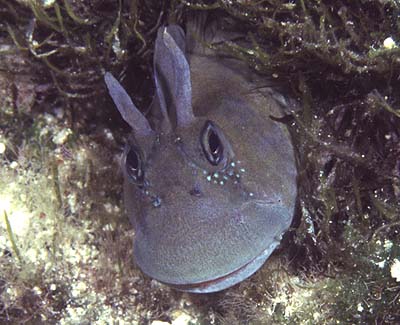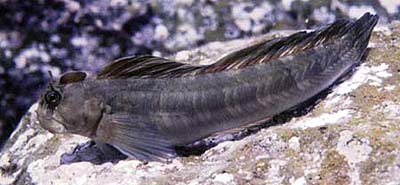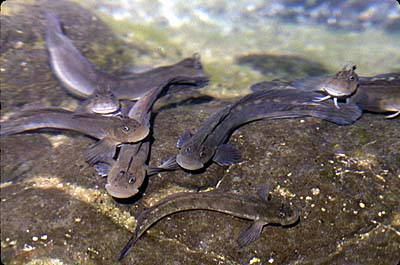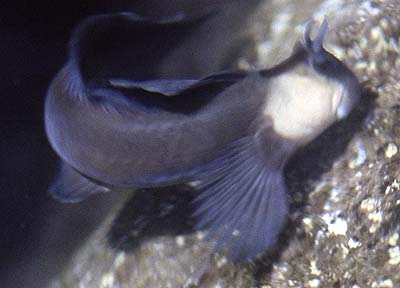|
hawaiisfishes.com
|
|
Home |
Fishes | Invertebrates |
Books | CDs
| Links |
Contact |
|
past
fishes of the month ZEBRA
BLENNY
|
 |
| ZEBRA
BLENNY · päo`o Istiblennius zebra (Vaillant and Sauvage, 1875) (JUMPING JACK, ROCKSKIPPER) Anyone who pokes about the rocky seashore is familiar with Zebra Blennies. They live in pools at or above the high tide line, generally along turbulent shores where basalt rock predominates. A small pool will sometimes support dozens of blennies, especially if there is ample shelter in the form of large boulders under which they can retreat. Their bodies vary from smart blue-black to charcoal or brownish gray with indistinct bars (hence the name). They become mottled when feeding in shallow water or when alarmed. Adults have a row of tiny bright blue spots under the eye. A crest and two tentacles (longer in males) adorn the head, but collapse entirely when out of the water. Zebra Blennies feed almost entirely on organic detritus that accumulates on the rocky sides and bottoms of their pools. They adapt well to the aquarium and make fun, alert pets that are unusually tolerant of temperature and salinity changes. If you keep one or more of these fish, be sure their tank is well covered. They grow to about 7 in. and are endemic to the Hawaiian Islands (but apparently absent from the northwestern atolls, which lack basalt shores). All photos were taken at Makapu`u Point, O`ahu. |
 |
 |
| Zebra Blennies fish swim with lateral undulations like little eels, their pectoral fins folded back along their sides. With the same motion, they can wriggle almost out of the water to bask in the sun, sometimes sprawling all over each other. They can spot a potential predator as much as 50 ft. away, and if alarmed can leap, slither and skip a surprising distance over the rocks, somehow knowing in advance the location of the next pool. They can even leap while swimming, sometimes 2 ft. above the surface! It is possible that they are evolving toward an amphibious existence. |
|
|
| Zebra
Blenny Reproduction Spawning occurs throughout the year but probably reaches a peak in spring and early summer. Large territorial males develop yellowish tan cheek patches that brighten to yellowish white when they chase intruders. The cheek patches fade when they leave their territories. Smaller males and females are not territorial. Typically, a male prepares a nest in a crevice then performs vertical loops to attract a female. The female cements up to 10,000 eggs to the crevice walls. The male fertilizes them then guards them until hatching (about two weeks). The larvae go to sea for an unknown period of time returning to pools when they are about 1/2 in. long. |
|
|
